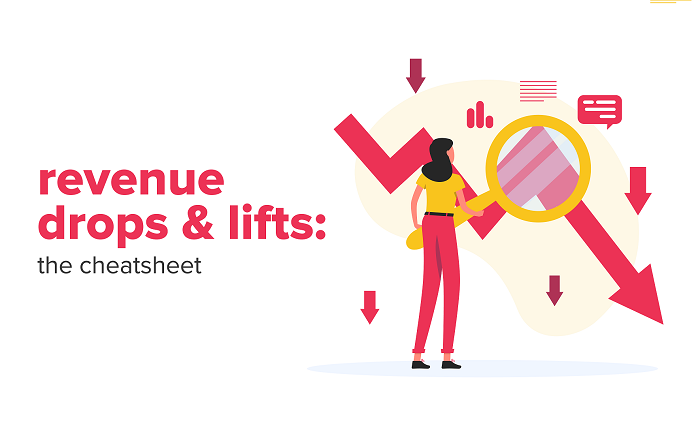Sticky Cube Desktop – an innovative ad format for maximizing monetization and UX
In today’s fast-paced digital advertising landscape, it’s more important than ever to strike the right balance between effective monetization and…

Sudden lifts might be an unexpected, but pleasant surprise. But what about drops? Random decreases in revenue might hurt your business. So in order to quickly respond to both lifts and drops, it is worth drawing up a list of possible reasons to see why either can happen. This is why we have prepared this cheat sheet, which includes the most popular incidents that influence Programmatic revenue.
The best way to track traffic is through Google Analytics. The first thing to check when you see a sudden decrease or increase in revenue should be the number of Page Views and Sessions.
As traffic trends might be different depending on the day of the week, remember to look at long periods of time, starting from the last 30 days up to last year in order to compare y/y trends. If one of your articles went viral, an increased number of Page views will result in an increase in the volume of ad requests. Keep in mind that GA Pageviews is defined as the total number of pages viewed: so depending on how many ads you have on your website (mobile and desktop) changes in Pageviews might not translate into the very same percentage increase or decrease in ad requests.
If you have recently introduced some changes to layout, content structure or different kinds of articles (different types of topics, or maybe creating galleries from photos), such changes might result in different kinds of user behaviour. Changes like these might be both positive and negative, depending on user expectations with respect to your site. To check this, we can turn again to Google Analytics. The metrics that interest us the most are Pageviews/Session, Average session duration and bounce rate. In a way, they are all linked together – if your content does not induce users to stay longer on your website, Pageview/Session and Session time will decrease, and bounce rate will increase. In GA, you can divide your traffic per Landing Page, and then you can see which articles are producing the highest and lowest bounce rate.
Bounce rate per article report can be acquired through Custom reports, as well as through the Behavior tab
Based on this information, you can influence users by creating more engaging content for your website.
Another useful information source is the Channels Report. It will tell you how your website saw an increase or decrease in traffic:
The Channels Report can be acquired through the Acquisition tab.
Whether Policy issues have been resolved or restrictions placed on your content, the effect will be visible in the revenue. Depending on what network you are using, policy restrictions may vary. When it comes to Google’s environment (Ad Exchange, AdSense) your restrictions will be visible in the Policy center. Violations of Policy may result in either Policy Restrictions or Publisher violations. The difference is, if you commit a violation, your website (or single article) will not be monetized at all. In the event of restrictions, some advertisers (Adwords including) may not choose to buy ad space due to its controversial content. And so, some revenue will still flow, but it might be in a small volume.
Types of content that will not be monetized by Google includes all sorts of illegal content or activities, such as the selling of endangered species, and unreliable or harmful claims. A full list is available in this Help article. Keep in mind that not only strictly monitored content can fall foul of policy violations, but advertisements and links to other websites/apps as well.
When it comes to restrictions, ad serving will be limited as Adwords will not buy inventory on content that falls under restriction. The most frequent restrictions are adult and shocking content. As the meaning of adult content is pretty understandable, shocking content might not be, and this includes shootings or bombings, profane language and gory imagery. You can find a full list of restrictions in this Help article.
Another version of policy restriction is the so-called ‘Confirmed click’ penalty. It can be placed on your mobile ads if Google’s system has determined that clicks on your website are accidental. It requires two clicks from the users instead of one to count the impressions as having been clicked. Here is the example:

Example of Confirmed clicks feature.
The first sign of this kind of penalty is a sudden and big decrease in the Click Through Rate. Due to the fact that this metric influences CPM, drops in revenue are inevitable. If you want to learn more about this penalty, refer to this article.
During holidays that revolve around spending time with family, festivities or the attending of gatherings, drops in both traffic and CPM might occur. This is important if you happen to have traffic coming from multiple different countries, or a country that is not of your origin and you are not familiar with its holidays. The Internet provides lots of pages regarding this topic, for example Office Holidays.
It can also be a positive thing, especially for events like Black Friday or in the run-up to Christmas. During these periods, Advertisers increase their spendings in order to promote upcoming discounts and deals, or present recommendations.
The effect of Black Friday can be visible in CPM trends, for example this is last year’s event in the USA geo. You can check it at the real-time Programmatic Ad Rate Index
During transitions of months, years, or quarters there are usually significant drops (in the beginning) and lifts (near the end). If we turn once again to the Ad Rate index, we can see that there is a visible lift in March (end of 1st quarter), the next one in April (due to Easter campaigns) and the last one in June (end of 2nd quarter):
Seasonality, based on an example of the USA CPM rate in 2021. Available at the Programmatic Ad Rate Index by Yieldbird
It allows you to compare your performance to global – divided by countries, products and devices, and find out whether transitions or some other occurrences have influenced your CPM.
Sudden changes in CMP can also be related to Advertisers. If your content and users match some of their campaigns, your revenue can quickly rise – and depending on the budget, this effect can last for several days. If Advertisers record sudden drops, there can be many reasons behind it aside from the burning out of campaign budgets. If you are using GAM, you should have access to Bid rejection reasons and Bid range metrics. Among the reasons for rejections are Outbid, Floor, No consent or Publisher blocked. If you add a bid range metric, you will see how many and in what range the bids are fall below your UPR. Another important item of information is how much traffic comes from the Advertisers blocked in protections – it is important to protect your inventory from competitors, but remember that with each blocked category your revenue stream may decrease.
There can be many reasons behind sudden changes in performance, but the most common ones revolve around traffic, seasonality and policy. Also, always keep an eye on performance after having introduced changes like floor prices in UPR, moved ad units around the website or added new partners or features (like refresh for example).

Karol Jurga
Chief Revenue Officer
See it in action.